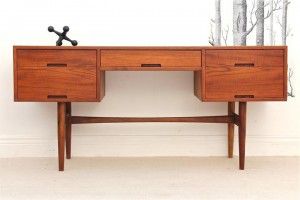About a month ago I received an email from Melanie, a reader of my blog ‘Australian Modern’ who contacted me to share some information about the acclaimed Australian furniture designer Hans Hayson. As it turns out, there is no Hans Hayson, rather it was Melanie’s father Cliff Hayton who had been the designer, part-owner and a Director of Melbourne based company Hayson Furniture Manufacturing Co. Pty Ltd.
I recently caught up with Melanie and her mother Peggy at Peggy’s home by the bay. Peggy showed me to her kitchen, offering a plate of ‘melting moment’ biscuits she had freshly baked that morning, whilst her daughter Melanie prepared a pot of tea. As we sat in the kitchen sipping tea we soon got talking about the past. When Peggy had first met her future husband Cliff Hayton in 1949, Cliff had already established furniture workshops in South Melbourne, Carlton and West Footscray, employing over 60 workers. According to Peggy, the ‘Hayson’ business name resulted from taking the first 3 and the last 3 letters from the surnames of company owners Cliff Hayton and Bill Ericsson. Perhaps not that dissimilar to the method used by Fred Lowen and Ernest Rodeck when they used the first two initials of their names to create the iconic FLER business name.
Initially the Hayson company had produced furniture that catered to a popular demand for bedroom suites in the ‘antique style’ (Fig: 1). Peggy noted that after WWll, newly married returned servicemen and women had wanted bedroom suites, often consisting of a bed, bedside tables, a chest of drawers and two wardrobes. Demand for Hayson furniture appeared to be strong at this time, with two sales reps (known then as travellers) constantly on the road, travelling through country Victoria, N.S.W. and Tasmania. Peggy recalls a large red van used to make deliveries, its side emblazoned with a Hayson logo designed by her husband, who was not only a self styled designer but also had a degree in economics and counted former Prime Minister Bob Hawke amongst his many friends.
According to Peggy, sometime during the 1950s there was a shift away from the bedroom to the dining room. The simplicity and style of the ‘Swedish look’ had captured the public’s imagination, so Cliff and Peggy soon found themselves travelling to Copenhagen in search of inspiration for a new range of furniture that would meet a growing demand in Australia for contemporary design. Being at the forefront of design also had its problems, and Peggy recalls that many furniture companies often raced to be on top of design trends, thus it was not uncommon for rival companies to copy designs, often resulting in protracted court cases. Peggy remembers things being so bad at one point that her husband hired a full time solicitor just to deal with companies copying the Hayson designs.
Always the innovator, in 1970 Cliff and Peggy commissioned an architect to build their young family a modern home in the international style. Melanie can still remember the rooms being filled with furniture made by her father, including a floating sideboard and a desk for his office (Fig: 2). A few years later, due to poor accounting advice, the Hayson Furniture workshop doors closed for the last time. According to Peggy, the unavoidable decision to close the business and lay off all the workers proved heartbreaking for Cliff, who never returned to the furniture business.
Before I leave Peggy offers a brief house tour. Underfoot in the lounge room is a patchwork of small Persian prayer rugs, their geometric patterns softened by years of sunlight. In the corner of the room sits an original Hans Wegner ‘Round Chair’ (1949), purchased on one of Cliff and Peggy’s adventures in Copenhagen in the 1950s. I draw Peggy’s attention to another Danish chair, it’s back upholstered in a 1960s inspired geometric tapestry of white and purple hues. “That’s one of my tapestries” says Peggy, “do you like it?” “It’s beautiful”, I reply, and in that moment I realise that Peggy has woven her memories of the past into the very chair that symbolises Cliff and Peggy’s shared passion for travel, art and design.
Looking at Cliff Hayton’s Danish inspired designs for Hayson Furniture (Fig: 3), they seem to encapsulate much of the simplicity and elegance so often associated with Scandinavian mid-century furniture design. Hayton’s signature can be found in the simple use of natural timber and the subtle draw pulls, a much admired design feature amongst the many individuals who admire these highly sought after Australian designs. The so-called ‘Swedish look’ was a major influence for furniture designers in post-war Australia and Cliff Hayton took advantage of the style’s popularity and produced a wide range of Danish inspired furniture which was designed by Cliff and proudly made in Melbourne. At long last we can stop confusing Hayson Furniture with the German-born Australian painter Hans Heysen. The name is Hayson, and the designer is Cliff Hayton.
With thanks to Melanie and Peggy Hayton.
See Mid-Century Modern: Australian Furniture Design at NGV Australia until 19 Oct.
Image 1. Cliff Hayton at the Hayson Furniture stand at the Exhibition Buildings, Melbourne in 1953. Photograph property of Peggy Hayton.
Image 2. Cliff’s office in the Myrtle Street home c.1970s.
Photograph property of Peggy Hayton.
Image 3. Hayson console in Queensland Teak, designed by Cliff Hayton, c.1960s.
Image courtesy of Permanent collection (http://permanent-collection.com)
